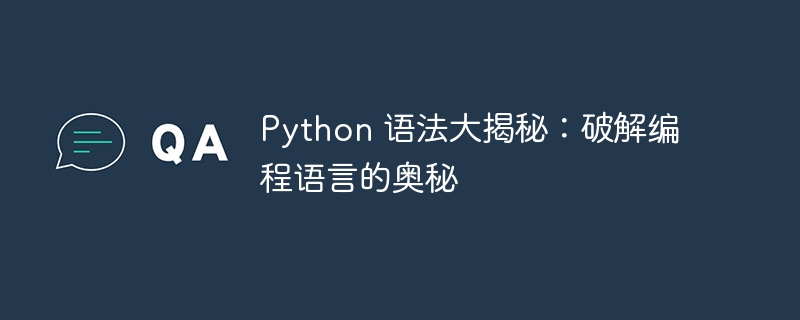

python Syntax, data types, variables, flow control, functions, modules, classes and objects
introduction
Python As a popular high-level programming language, it is widely popular for its easy learning, concise syntax and powerful functions. A deep understanding of Python syntax is essential to mastering the language. This article will provide an in-depth analysis of various aspects of Python syntax to help you decipher the mysteries of this language and realize its powerful potential.
type of data
Python has a variety of data types used to represent different types of data, including:
Variables and assignment
Variables are used to store values and can be assigned values using the assignment operator (=). For example:
name = "John" age = 30
Process Control
Python provides powerful flow control statements for controlling program flow:
function
Functions are used to encapsulate blocks of code and perform specific tasks. They can accept parameters and return values. For example:
def greet(name):
print("Hello, " + name)
greet("John")# 输出:Hello, JohnModule
Modules are reusable units of Python code that provide specific functionality. You can import modules using the import statement, for example:
import math print(math.pi)# 输出:3.141592653589793
Classes and Objects
Python supports object-oriented programming, where classes define object types and objects are instances of classes. For example:
class Person:
def __init__(self, name, age):
self.name = name
self.age = age
john = Person("John", 30)
print(john.name)# 输出:JohnOperator
Python provides a variety of operators for performing arithmetic, logical and comparison operations:
Special methods
Special methods (also called magic methods) in Python start and end with double underscores and are used to define specific behaviors of objects, for example:
__init__:Constructor of object__str__: String representation of the object__add__: Object addition operationAdvantages of Python syntax
Advantages of Python syntax include:
in conclusion
Python syntax is the foundation of the language’s power. With a deep understanding of its data types, variables, flow control, functions, modules, classes, and objects, as well as operators and special methods, you can master the secrets of Python and build efficient, maintainable, and scalable applications.
The above is the detailed content of Python syntax revealed: cracking the secrets of programming languages. For more information, please follow other related articles on the PHP Chinese website!
 How to use split in python
How to use split in python
 How to implement line break in alert
How to implement line break in alert
 How to export pictures to pdf
How to export pictures to pdf
 What are the methods for restarting applications in Android?
What are the methods for restarting applications in Android?
 Introduction to the relationship between php and front-end
Introduction to the relationship between php and front-end
 What are the javabean attributes?
What are the javabean attributes?
 How to check website dead links
How to check website dead links
 Bitcoin buying and selling process on Huobi.com
Bitcoin buying and selling process on Huobi.com




